Around the Neighborhood - Volume 2, Number 6
In 1973, Family Communications initiated a print newsletter titled Around the Neighborhood. This newspaper-like publication was largely directed towards parents but included some material for children as well. The information below documents the sixth issue from Volume 2 of Around the Neighborhood.
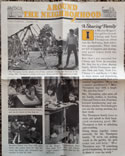
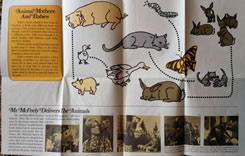
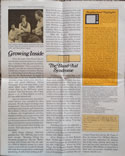
[click images for larger view]
Articles Included:
- A Sharing Family
- Animal Mothers and Babies
- Mr. McFeely Delivers the Animals
- Growing Inside
- The Band-Aid Syndrome
- Neighborhood Highlights
Articles
In Mister Rogers' Neighborhood, Chrissy and Terri Thompson often visit the McFeelys, their television grandparents. Their visits are full of laughter and sharing, and quiet times with the McFeelys.
But that's not unusual for Chrissy and Terri. In everyday life, they live in a close, sharing family. All the Thompsons -- parents Dick and Judy, Terri (10), Chrissy (9), and Becky (4) like to share music and picnicking, camping and growing their own summer vegetables. "We're not organic gardeners," Mrs. Thompson says with a laugh. "We just love food."
Mrs. Thompson, who sews all the family clothes, is teaching Chris and Terri to sew. First they learned hand sewing and embroidery stitches. Now both girls can use the sewing machine for their work.
The Thompson family loves to swim and splash in their backyard swimming pool. Mr. Thompson is best at splashing and wrestling.
Doing things together comes naturally for the Thompson family. "If we're out pulling weeds in the garden, the girls come out and help," Mrs. Thompson says. "If something good is happening, the kids want to share it, even the work."
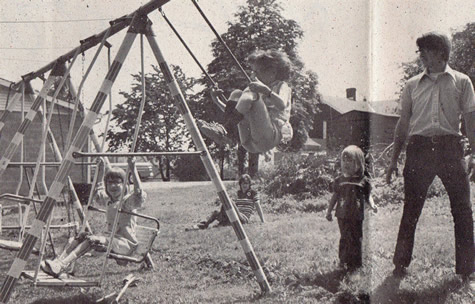
The Thompson family spends a lot of time outdoors. Chrissy and Terri are in the swings, Mrs. Thompson is sitting on the grass. Becky and Mr. Thompson are at right.
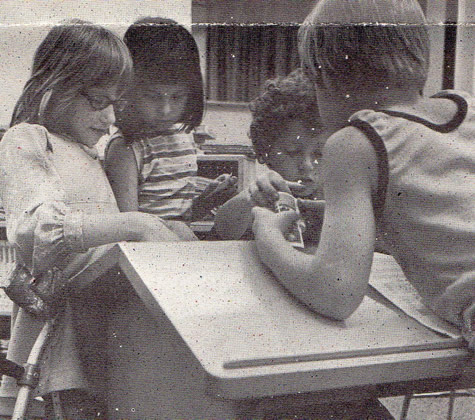
Chrissy has fun at school with her friends, and can do almost all that they do.
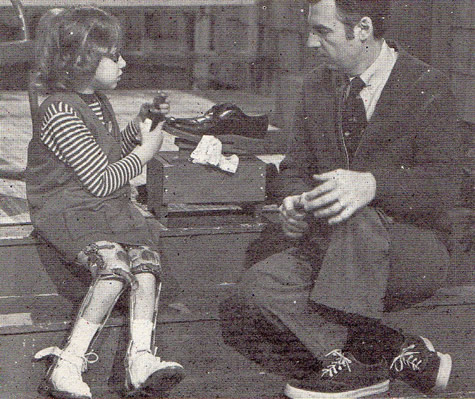
Because Chrissy was born with spina bifida, she cannot move her legs. She wears leg braces and sometimes uses crutches to help her walk.
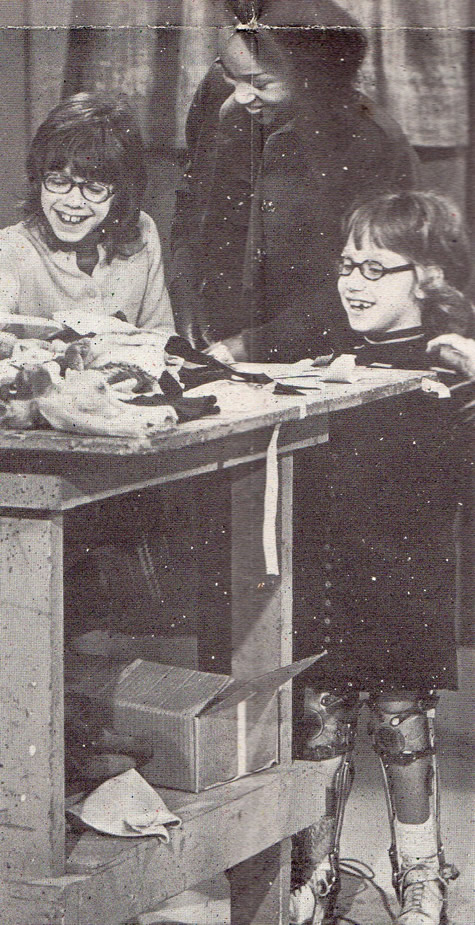
On Mr. Rogers' Neighborhood, Elsie Neal helps Terri (left) and Chrissy (right) prepare a puppet show for the McFeelys.
When a baby animal is first born or hatched, it looks very different from its parents. The mother knows her baby though, even if it is fuzzier than she is or a different color. And even though it is much smaller and helpless, each baby knows its mother.
At first a baby needs its mother to feed it and keep it warm. Then as the baby grows its mother helps it to learn the things it needs to know for itself.
Only a mother duck can have a baby duckling. A mother cat can have only a kitten. So in time, each animal baby will grow up to look like its parents. Each animal baby, by the time it is grown, will know what it can do to care for babies of its own.
MR. MCFEELY DELIVERS THE ANIMALS
Mr. and Mrs. McFeely love animals. They like to feed and care for the many animals that visit Mr. Rogers' Neighborhood. Each animal has its own special personality and needs. For instance, Mr. McFeely had to be careful with the two playful lion cubs -- they were pretty big and strong! He had to watch the monkey to make sure it did not scamper all over the place. And he had to keep the penguins, who love cold and icy places, from getting to hot.
Here are some of the animals Mr. McFeely delivered to Mister Rogers' Neighborhood: (1) a cow named Harriet, (2) a small monkey, (3) three little pigs from a farm, (4) a horse Mister Rogers is riding on, and (5) a duck that sounds like a horn when he quacks.
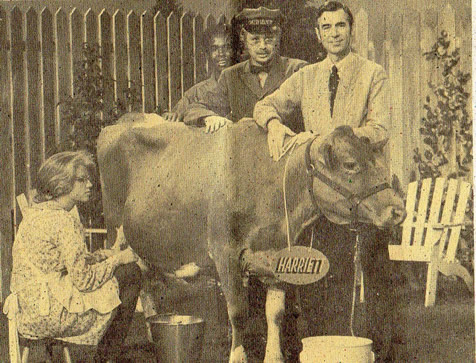
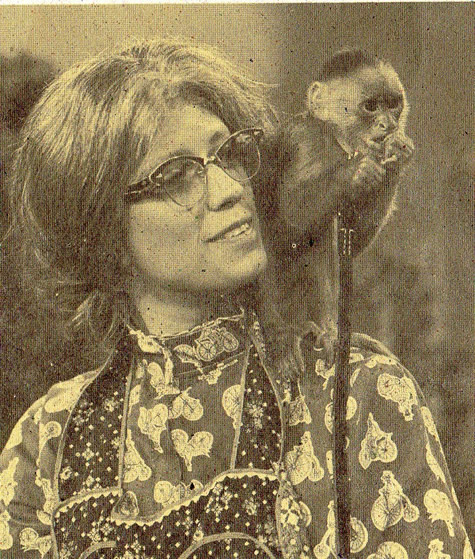
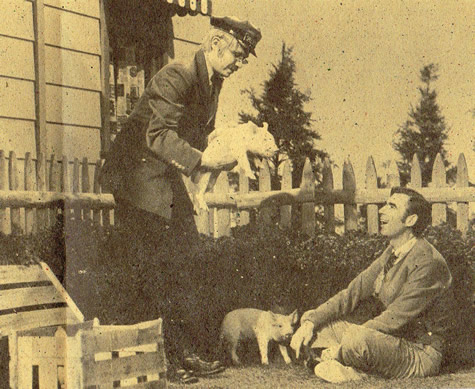
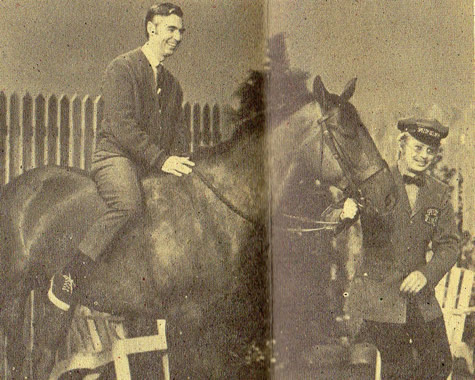
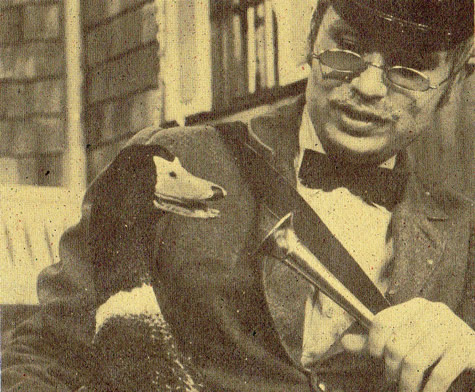
Over the years, Fred Rogers has received many poignant letters from the parents of children with physical disabilities. He has learned that "I like you just the way you are" can take on a special meaning to a child who is blind or on crutches. Recently, with funding from the Bureau of Education for the Handicapped, he began to focus parts of the new program series to introduce young viewers more directly to those with special difficulties. Chrissy Thompson (born with spina bifida, a condition which makes walking difficult) visited often as the McFeelys' granddaughter. And Tim Scanlon, who is deaf, played a role in Make-Believe as well as his own multi-talented self.
Special administrators and educational advisers were consulted for these programs. But the biggest learnings came unexpectedly. They came directly from the performers and program staff themselves. Barry Head, a fulltime staff administrator of Bureau and Neighborhood activities, found it took him a year to get over his early uneasiness with Tim and Chrissy. "When you first meet a person with disabilities, you start to feel barriers coming up inside you. It helps to tell yourself those feelings are natural. Then you can get on with the relationship."
Betsy Nadas, Chrissy's "television grandmother," Mrs. McFeely, puts it even more strongly. "Knowing Chrissy has absolutely changed me," she says. "Before working with Chrissy and Tim, the sight of a blind or disabled person on a street corner would make me wonder if I should offer help, then wonder if that would sound patronizing. Finally I'd do nothing at all."
Betsy felt the same discomfort at first with Chrissy and Tim. She treated Tim as if he were much younger, using only simple words to speak to him. To her surprise, she realized that deep down she felt angry with Tim -- she wanted him to hear, to stop being deaf! Working together, observing casually, and most of all, spending easy time together, Betsy found that understanding and easiness began to grow.
What Mr. Rogers' Neighborhood learned was that prejudice and self-consciousness do break down inside a warm personal relationship. As Barry Head has said, the most surprising thing is to look back and see how much farther you had to come than Chrissy or Tim, and to see how much you had changed because of them.
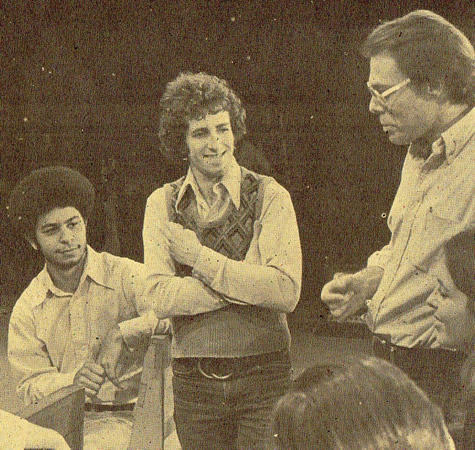
Tim Scanlon (center) shares some quiet times with a friend from the National Theatre of the Deaf (left), and Barry Head (right).
It takes a lot of growing time to develop sophisticated concepts of the body. Some small children can worry that their arms and legs might be hollow inside, like the limbs that can come off a doll. A child who watches all the stuffing leak out of a ripped rag doll may reason that his or her insides too can all fall out from a cut. For a while, a band-aid might be demanded for each tiny scratch -- just to be sure.
Sometimes children seem not to notice unusual physical disabilities or differences in other people. Yet other times they may notice in very loud voices, or by pointing and staring. One thing we can be sure of is that they do notice other people's bodies very carefully. It's good to ask children what they think about an unusual disability. A small child who asks about a disability may also be asking, "Can that happen to me?"
Sometimes a book can approach a tough subject from a safe distance, or can act as a springboard for the deeper talks a child may need. Here are some good ones dealing with difficult subjects.
About Handicaps by Sara Bonnett Stein (Walker and Company) tells how one small boy accepts the friendship of a boy who "walks funny." Where the Wild Things Are by Maurice Sendak (Harper and Row) is an imaginative journey to the sources of nightmares for children who can conquer things they can see. My Puppy Is Born by Joanna Cole (William Morrow and Company) underlines the message that living things innately know how to grow and stay well. Apartment 3 by Ezra Jack Keats (MacMillan) is about how a blind man can produce beautiful music without using his eyes.
Note: If you miss a program that you or your child is particularly interested in, check with your local station to see when it will be repeated. Give them the program number.
Week of November 4
Monday (#446) Lady Elaine decides to wallpaper the outside of King Friday's castle and magically rearrange all the houses. People get lost on Tuesday (#447), and finally on Thursday (#448), when she hears little Ana Platypus crying, Lady Elaine puts the Neighborhood back in order. Friday (#450) the neighbors declare a Festival of Mad Feelings to express their anger over what Lady Elaine did.
Week of November 11
Monday (#451) Morrie Turner, the cartoonist who draws the "Wee Pals" comic strip, draws caricatures of Mister Rogers and his neighbors. Tuesday Mister Rogers shows a leg brace and crutches (#452) before he goes to visit the McFeelys and their granddaughter, Chrissy Thompson, who uses a brace and crutches to help her walk. On Friday, (#455), Lady Elaine, Lady Aberlin, and Harriett E. Cow form a singing trio.
Week of November 18
A professional pizza maker visits Chef Brocket's Bakery on Wednesday (#458) and everyone has a chance to practice throwing pizza dough up in the air. Thursday (#459) is the day to work on safety rule, and Friday (#460) Ezra Jack Keats visits Mister Rogers with his book Dogs on Roller Skates.
Week on November 25
A clown appears in the Neighborhood of Make-Believe Tuesday (#462), looking for his lost friend, the Purple Panda. King Friday agrees that the Panda can go live with the circus if the circus will come to the Neighborhood of Make-Believe -- which it does, with great fanfare on Friday (#465). The McFeelys have a monkey to show Mister Rogers on Wednesday (#463).
Credits
Around the Neighborhood and the materials that accompany it are published ten times a year by Family Communications, Inc., a not-for-profit Pennsylvania corporation. Mister Rogers' Neighborhood is funded by grants from the Sears-Roebuck Foundation and the Corporation for Public Broadcasting.
Around the Neighborhood is created in association with Media Projects Incorporated of New York. Subscriptions, printing, and distribution are accomplished by Multiscope, Inc., Pittsburgh, Pa.
Executive Editor: Sara Stein
Editor: Barbara Staib
Editorial Consultant: Hedda Sharapan
Psychological Consultant: Dr. Margaret McFarland
Graphic Designer: Fred Poffenberger
© 1974 Family Communications Inc.
